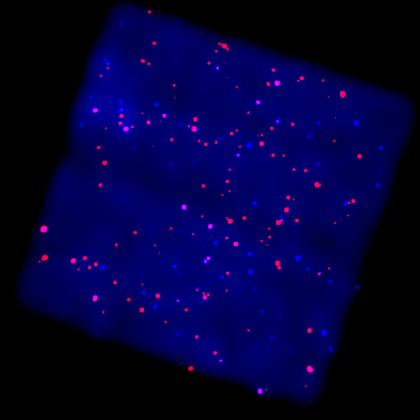Astronomers Go Behind The Milky Way To Solve X-Ray Mystery
This Chandra image marks the deepest X-ray look at the "zone of avoidance" -- a region of space behind which no optical observation has ever been taken because thick clouds of dust and gas in the spiral arms of the Milky Way block visible radiation. X-rays, along with certain radio and infrared wavelengths, can penetrate this barrier, and Chandra provided the best look yet at what X-rays reveal. The diffuse blue emission is due to hot (ten million degree Celsius) gas concentrated along the plane of the Galaxy.
Most of the pink and red objects sources in this image are believed to be active stars in our Milky Way galaxy. The blue objects, referred to as "hard" sources because they emit more energetic X-rays, are considered to be distant galaxies. Because astronomers were able to identify these objects as being well beyond the galactic plane, they were able to determine that the X-ray glow from the galactic plane comes not from individual sources, but from the hot diffuse gas.
Chandra observed this region of the galactic plane in the constellation Scutum on February 25-26, 2000, with its Advanced CCD Imaging Spectrometer instrument for a total exposure time of 90,000 seconds.
|
||||||||||||||||||||||||||||
The Chandra X-ray Observatory image of the plane of our Milky Way galaxy presents a unique visual representation of a part of our galaxy's core. At the center of the image, there is a tilted royal blue-colored square. This Chandra image marks the deepest X-ray look at the time of observations of the "zone of avoidance" -- a region of space behind which no optical observation has ever been taken because thick clouds of dust and gas in the spiral arms of the Milky Way block visible radiation. X-rays, along with certain radio and infrared wavelengths, can penetrate this barrier, and Chandra provided the best look yet at what X-rays reveal. The diffuse blue emission is due to hot (ten million degree Celsius) gas concentrated along the plane of the Galaxy. Most of the pink and red objects sources in this image are believed to be active stars in our Milky Way galaxy. The blue objects, referred to as "hard" sources because they emit more energetic X-rays, are considered to be distant galaxies. Because astronomers were able to identify these objects as being well beyond the galactic plane, they were able to determine that the X-ray glow from the galactic plane comes not from individual sources, but from the hot diffuse gas.





